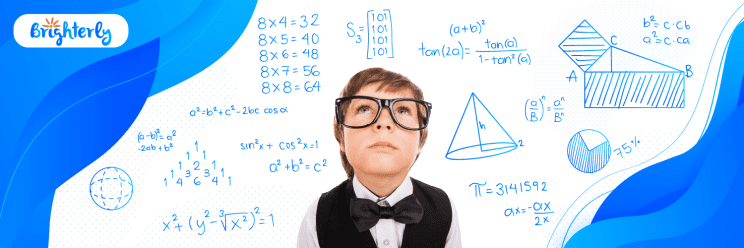11 Mental Math Practice Tips
reviewed by Jo-ann Caballes
Updated on July 22, 2024
Fans of AI tools often call mental math an outdated practice. However, it is still important both for kids and adults since it gives you more than just easy device-less calculations. This practice sharpens cognitive skills and boosts overall confidence.
That’s why you can still see dozens of topics like “How to improve my mental math?” and “How to get good at mental math for a school student?” on every education-related forum. So, today, we’ll share 11 proven tips to boost those calculation skills!
What is mental math?
Mental math is the practice of performing complex calculations without calculators and other support materials. With it, you can visualize numbers and manipulate them right in your head.
Mental maths practice sharpens cognitive skills, acting like a brain gym. It exercises memory, concentration, and problem-solving skills. It builds a solid understanding of numbers and their relationships. Mental arithmetic practice also boosts students’ confidence and eases daily chores like grocery shopping.
How to get better at mental math
As the first step in enhancing mental math, build a strong knowledge foundation. Use flashcards or write them out repeatedly. Ensure the student is familiar with place values to break down large numbers.
Master it by practicing mental math skills. Break down complex problems into multiple simple tasks. Don’t be too strict, and allow your child to use estimations. It is a great way to check for reasonableness after you solve the problem. Use secrets of mental math, such as number tricks. Below, we will show you how to use those tips in real life.
The Real-Life Example Of Mental Math Tricks: Divide by 5
Imagine the number has a decimal point. Move it one place to the left, so you divide the number by 10. Multiply this number by 5 and remove the decimal point. It may sound complicated, but it’s easy to calculate. For example, multiply 23 by 5:
- Move the decimal point one place to the left. Instead of 23, you’ll get 2,3.
- Multiply it by 5. As a result, you’ll get 11,5.
- Remove the decimal, transforming 11,5 to 115.
As you see, this trick allows you to provide even complex calculations within seconds. Try it with any number to see how it works.
How to improve mental math with Brighterly
Brighterly tutors will boost your child’s mental math skills. Our tutors are interested in improving students’ lives, not just memorizing. We help students grasp the “why” behind math concepts.
Out tutors find out students’ weak areas to improve child’s math skills with tailored curriculum. That way we can find how to improve their skills important for mental math. We begin with the fundamentals, ensuring a solid base for more advanced mental math.

Brighterly tutors use games and interactive mental mathematics activities to keep our students engaged. We create a supportive learning environment where children can feel totally comfortable.
How to practice mental math?
- Use flashcards
- Implement shortcuts and tricks
- Gamify study sessions
- Make math a part of your routine
- Practice with a timer
- Start simple and gradually ascend
- Visualize the problem
- Introduce mnemonics
- Play estimation games
- Encourage the usage of digital tools
- Use the tutor’s help
Let’s examine each tips in detail. That way, you’ll find out which one of them suits you best.
1. Use flashcards
Ensure that flashcards match the child’s age to make it really interesting for a young student
Flashcards are a classic method both in STEM and the humanities. You can improve mental math by writing down math facts (addition, subtraction, multiplication, division) on one side and the answer on the other.
2. Implement shortcuts and tricks
Test the trick to avoid potentially embarrassing situations
Ensure that students leverage math tricks when they practice mental math. The most common tricks are multiplying by 5 and 9, and dividing by 3 and 25. You can research dozens of mental math tricks that suit your current case.
3. Gamify study sessions
Play together with a kid to create a strong mental bond
Make learning math fun. Add board games, puzzles, and educational apps into study sessions. Turn a lesson into playtime. Look for games that engagingly challenge mental math skills.
4. Make math a part of your routine
Incorporate math even into the most boring parts of daily routine
Build core mental math skills by making it part of the child’s daily routine. Use math to estimate grocery bills, calculate shopping cart totals, etc. Turn these tasks into quick mental math challenges.
5. Practice with a timer
Put a popcorn bag in the microwave and eat some junk food after a successful math session. It encourages kids to be more effective during drills
Set aside 5 minutes for mental math drills. In the first few study sessions, the child might get easily distracted. But as time passes, you’ll be surprised at what your child can achieve if they focus on nothing but math.
6. Start simple and gradually ascend
Don’t overwhelm your kid. Keep it easy
Don’t overwhelm your child with complex problems while you practice mental math skills with them. Begin with addition and subtraction, then progress to more complex multiplication and division.
7. Visualize the problem
Just as you manifested this article to help you, ensure that your kid manifests and visualizes the math in their mind
Make math feasible. Visualize it in real life. You can use any objects to link associations. For instance, apples can be 10s, pears – 100s, bottles of water – 1000s, etc. This visualization can be in the physical world or in the student’s mind. The main aim is to create a link between math and some chosen object.
8. Introduce mnemonics
Even Lisa Simpson is aware of the benefits of mnemonics!
Incorporate mnemonics into the learning routine. Find the preferred learning style of your child and incorporate those mnemonics into their routine. If they like to sing, find some songs. If they prefer acronyms, use them. If they like funny associations, incorporate them.
This technique boosts their math understanding. For instance, instead of rote memorizing the order of math operations, use the phrase “Please Excuse My Dear Aunt Sally” to remember Parentheses, Exponents, Multiplication, and Division (from left to right), Addition and Subtraction (from left to right).
9. Play estimation games
The main point of those games is to have a good time and learn to estimate to ease students’ future adult life
Try some games to make lessons more entertaining. Meanwhile, make them math-related so kids can still learn math. We like “Guess the jar”, “Mystery measurement” and “Hello, shopping”. They are fast and easy to understand, so you can create a short and fun 5-minute break in the middle of the study session.
1. “Guess the Jar”:
- Take a jar and fill it with some small objects. It can be anything you want: marbles, buttons, or even M&M candies.
- Ask students to estimate how many objects are in a jar. Provide some valuable prizes for winners. It can be a good grade or even the M&Ms from that jar.
- Discuss estimation strategies. You can tell kids about rounding or using place value.
2. Mystery measurement
- Pick any object in a room and ensure that all students can see it.
- Ask students to write estimated measurements in a chosen unit (centimeters, inches, etc.).
- You’ll reveal the actual measurement and discuss the estimation strategies.
3. Hello, Shopping
- Gather grocery store ads or online product listings with prices.
- Divide students into groups and give each group a “budget”.
- Ask students to estimate the total cost of purchasing a specific list of items.
- If you want to make the game even more challenging, collect coupons and ask students to save as much money in their budget as possible.
10. Encourage the usage of digital tools
If your child is already spending all their free time on the phone, make it productive
Modern kids prefer online services, no matter what you taught them. So, why should you block this habit, making young students uncomfortable? Allow them to use digital tools, but ensure that those services boost the child’s creativity.
Many apps adapt to students’ needs, providing targeted practice and challenges. It would be great if the tool could give instant feedback.
11. Use the tutor’s help
Look for a “cool teacher” type of tutor. They have a strong bond with kids, encouraging them to learn math
Some kids are more focused on humanities than others. So, they naturally need more time to understand STEM sciences. The easiest way to teach those kids math is to use a tutor’s help.
Unlike a one-size-fits-all approach in apps or group lessons in traditional classes, a tutor can easily identify areas for improvement in a child. Later, they can use it to create a tailored learning plan to solidify and upgrade their math skills.
How to learn mental math?
Learning mental math is easy, but it takes time. It isn’t just a party trick; it is more like a constant exercise for students’ minds. Implement easy calculations into a daily routine to get better at mental math.
Experiment and find which mental math tricks work for you. Some people might visualize colors or shapes associated with numbers. The key is to develop a mental picture that helps you connect with the problem and manipulate the numbers effectively.
Don’t overwhelm children with complex problems when you make mental math practice. Begin with basic addition and subtraction, then gradually progress to multiplication and division. Celebrate each child’s milestone as their confidence grows.
How to improve mental math skills?
To improve mental math skills, go back to basics and start everything from scratch. By it, we mean a brief recap, even of the 1st grade math. Visualize every step, and don’t be afraid to use postcards and provide rough estimations.
Be consistent and find your own learning style. There is no “one-size-fits-all” solution when it comes to ensuring that your child will get skills developed through this mental math practice.
What is mental math in 3rd grade?
Mental math is feasible even for 3rd-grade students. Benefits of mental math for elementary school students include, but are not limited to:
- Better understanding of double- and triple-digit numbers.
- Faster addition, subtraction, and multiplication.
- Easy understanding of math fractions.
- Confidence boost.
What is mental math for grade 4?
In 4th grade, mental math takes a leap forward, building on the skills students learned in 3rd grade. Here is how tasks your child solves with mental math can benefit them in their syllabus:
- Improved multiplication and division
- Enhanced number sense
- Understanding of factorization and multiplication in it
- Better work with fractions
- Basic geometry understanding
Just like in 3rd grade, mental math in 4th grade has some awesome benefits like sharper mind and a stronger foundation for complex math.
Wrapping Up
While you improve the mental math skills of your child, you provide them a gift that will be visible even decades after. It sets the foundation for success in STEM subjects and beyond. But where do you begin?
Brighterly Tutoring can be your partner on this journey. Our expert tutors don’t just teach; they create a personalized learning experience that builds a strong foundation for elementary and middle school students, ignites curiosity, and makes mental math fun!
Ready to unlock your child’s full potential in math? Schedule your free first lesson today! During this session, our tutors will conduct mental math practice online to assess your child’s current skills and needs and design a customized curriculum. Take the first step towards a brighter future in math for your child. Book your free lesson at Brighterly and watch your child succeed!













